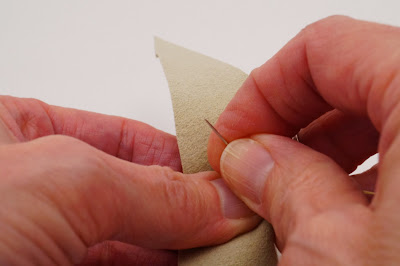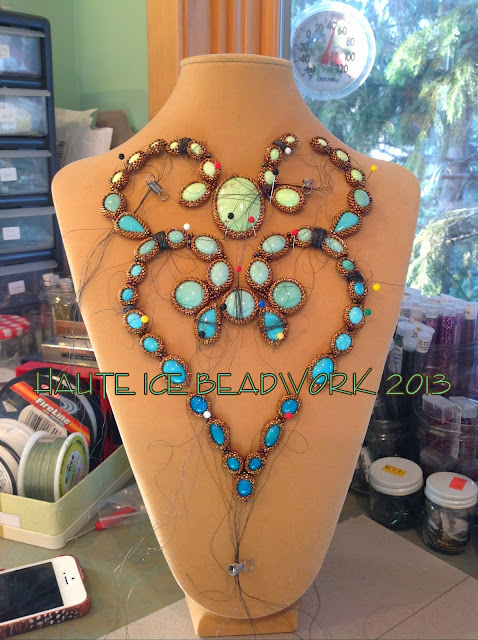A reader, Jen, contacted me about some of the things is use in my work, and asked that I write about my tool kit. It has taken me a while to assemble this post, but finally, here we go!
I think MOST of the tools I use and how I use them are common place, but I do a few things differently than most beaders. So to begin I will talk about the use of thimbles. I use one. ALL the time. Depending my my mood and the project, I choose between two different kinds. One, I began using when I was tailoring at the Guthrie Theater.
Every professional tailor I know uses a thimble, and most professional stitchers do too, but I have never run across another beader who does. I generally prefer my open-end tailors thimble above. It's cooler, and usually my go-to choice in the summer. Whether open or closed, every thimble has dimples, which allow you to connect with the eye of the needle in a slip-free way.
Fit matters. Your thimble must be snug, but not tight, on your middle finger, and it should not contact your first finger joint when your finger flexes. Blow into it before you put it on, and the moisture from your breath helps seal it to your finger. When I first tried to use a thimble, I had been sewing for at least 10 years. It felt ridiculous, bulky and unpleasant, and I thought I would NEVER get used to it. But after a few days of constant use, I found I could not do without it. It eases the stress through your entire working hand and arm, and I find even my shoulder tenses if I do not have a thimble and try to sew or bead. I am also faster with it, because you can connect the two step, push and pull process that is sewing into one fluid motion.

Here is the beginning of a stitch, which could be through a bead just as easily as fabric. You are holding your needle in your dominant hand, and your work in the other. You aim the stitch you mean to take, and push the needle into the right spot. If you are sewing without a thimble, you must do this by SQUEEZING your finger and thumb tightly on the needle, and then let go of the needle, move your fingers to the other side of the stitch, SQUEEZE it again and pull it through. But if you are wearing a thimble, your fingers can relax on the needle and just steer, while your middle finger does all the pushing. The side of your middle finger keeps the needle moving, while you re-position your fingers on the other side of the stitch. I moved my thumb out of the way to show you how my middle finger is positioned in this picture.

The middle, thimble-armoured finger pushes the needle along its path, all the way to the eye, while your fingers reposition themselves to provide the final impetus that finishes each stitch. So here is the end of the stroke, with my thumb and index finger pulled out of the way to show you the process.
But really, my fingers slide straight across the needle, to reposition and ease the needle through the final step of the stitch.
For me, this is just a faster, easier, and less stressful way to take a stitch. My most critical tools are my thimbles. I buy them at
Wawak.com and this link will take you to the two pages of thimbles. Skip past the Clover and Dritz offernngs, to the "Wawak"ones. ( If my memory serves, the even numbered ones are English and the odd German, but this could be entirely wrong!) I have very small fingers and wear a 4 or 5. An average finger is probably an 8 or 9. You may have to try several to get a good fit, or you may find that in the summer, you prefer a larger size and a smaller one in the winter. It's worth fiddling around and getting good ones. I have many, because I can lose a couple in a day as I work. You will see Russian thimbles that have slots instead of dimples and they work OK, but, for me, the best control happens with the dimples. Quilters leather thimbles? Metal cut-aways? what ever works best for you.

This is my favorite thimble. I took it from my mom's sewing chest when I cleaned out her house, and it has a lovely feeling on my hand. I have since done some research, and I think it was my Great Paternal Grandmother's engagement gift. Before the DeBeers made diamonds the engagement gift requirement, thimbles were made by gold and silversmiths, and since household skills were valued, they were common engagement gifts. I love how it fits, almost as though made for me, and I love the attached karma.
Jen asked specifically about two tools I use all the time, for thread control, and I'll talk about these tools next. First
Bead Stoppers. This link goes to the Beadalon site, one provider of these little goodies, and they provide lists of retailers who sell their products.
I use these all the time in many ways. Almost every time I begin a new component, I use this handy wire spring clip to determine how much tail I want to leave, and then to establish tension to make starting easier. I clamp the stopper an inch or two from my starting point, slip it to the back of my hand between my middle and ring fingers, and work against the tension provided by the stopper. I leave the stopper in place while I work, moving it further from my work and allowing gravity to keep the tail away from my fingers and needle.
When I have multiple components and am working on layout, I can clamp threads for groups of components together to keep them out of my way and the handy loop on the stopper can be pinned to my form, like this:
In a couple places you can see I wrapped my many threads around the work, but this is a silly idea and invariably results in knots and tangles. Don't do it. :)
Once it is time to sew together multiple components, I use a different tool for thread control. The stoppers are great in planning, and for individual components, but they do tend to catch my thread if I am joining many components at once. So, time for the EZ Bob Bobbin!

I almost always use the longest thread I can manage when I bead, and leave a healthy tail when I begin. I find that having thread available for connections and embellishment,without having to add improves the neatness of beadwork. When I finish a component, I secure the thread so I COULD cut it off, but I never do until the very end of the project. So I often have many working threads available. I control all those threads while I bead with EZ Bobs. They are made for use as kumihimo bobbins for beginners, and are available at most yarn shops. I found listings on Amazon and eBay too, and I know many bead shops sell them as well. The fact that when closed they are a smooth round dome with no corners or edges to catch my thread is great. I can capture many threads together, usually using a bobbin for each side of the work, or if its really big, each section of work, and still be able to bead without getting caught on the multitude threads or the spring ends of the Bead Stoppers. Sometimes I even combine both means of thread control!

Bead stoppers can also be used in stringing and testing fit. I use a small stopper for each strand I am stringing, and a big stopper to tie the stoppered ends together to test fit.
I could go on. I am a wordy girl! But it was the thread control devices I was asked about and it was quite a while back. And this post is plenty long without my taking on threads and conditioners, which would be my next thought. So Jen, I hope this answers the questions you had, and if anyone is curious about anything else they see me doing, please just ask and I will try to respond in a more timely way!



















